Here's a brainteaser for you: How many Lego bricks do you think exist in the world? Millions? Billions?
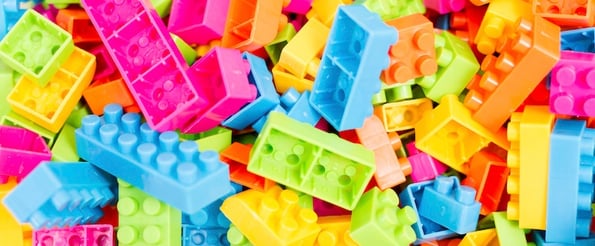
... How about hundreds of billions? According to Lego's website, there are 86 Lego bricks for every single person on the planet; about 600 billion Lego bricks have been created since 1958.
Lego has been a household name for decades, and it remains one of the strongest brands of all time. In 1999, it was named "Product of the Century" by Fortune Magazine. In 2008, Lego's owner Kjeld Kirk Kristiansen was inducted into the U.S. Toy Industry Hall of Fame. And these are only two of the plethora of awards the company has won over the years.
What makes Lego's popularity over several decades especially impressive is that the Legobrick has had the exact same design since 1958, thanks to a patent. This is a testament to both the quality of the product and the strength of Lego's marketing plan. According to Adweek, the key to Lego's success has been the consistency in the brand's look and feel, coupled with the company's ability to adapt just enough to "change with the times and broaden its market."
Lego's brand strategy continues to succeed through the 21st century, though, is thanks to how the company has adapted to the changing consumer relationship. In Lego's history, not only has the company done a great job with traditional advertising to their target market (young boys), but it has also successfully built and fostered active communities of fans and followers, created engaging pages on its website with games and marketplaces, and begun marketing specifically to both adult fans and young girls.
Want to learn more about the growth of LEGO's iconic brand? Listen to this episode of The Growth Show featuring Michael McNally, LEGO's Senior Director of Brand Relations.
A History of Lego's Marketing Plan
Timeline of Lego's Marketing History
1932: Ole Kirk Christiansen founds Lego
1940s: Invention of interlocking blocks
1954: Marketing directed at a child's imagination
1958: Invention of current Lego brick model
1968: First Legoland resort opens in Billund, Denmark
1970s-1990s: Marketing shifts
2000: Marketing to adults
2005: Lego Ambassador Network
2005: The Lego Factory
2006: Shadow Print ad campaign
2008: CUUSOO's idea crowdsourcing
2011: Website redesign
2012: Friends line for girls
2013: Female-oriented ad
2014: The Lego Movie
1930s – 1940s
The Lego Group was founded back in the early 1930s in Billund, Denmark, by a man named Ole Kirk Christiansen, the tenth son of a poor Danish family. The company has actually remained in the family ever since, passing from father to son to grandson, Kjeld Kirk Kristiansen. (Kjeld's last name starts with a "k" instead of a "ch" due to a mispelling on his birth certificate.) The name "Lego" comes from the abbreviation of the two Danish words "leg godt," meaning "play well" -- a sentiment it has carried through the decades.
Like every global enterprise, Lego had humble beginnings. You know it as one of the largest toy manufacturers in the world, but it started as a small carpenter's workshop with only a handful of employees, struggling through the tribulations of World War II. Ole and his small workshop produced a variety of wooden toys during the 1930s and 1940s, but they didn't see much success selling them in a world rife with poverty and war.
There isn't much recorded about Lego's marketing efforts during the first several decades since its founding. But these years saw a few critical changes: Ole purchased a plastic injection molding machine and began making plastic toys, like the Ferguson Tractor below that sold over 75,000 units.
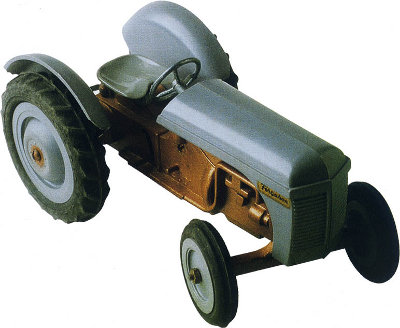
Image Credit: Toys.
Secondly, Lego started making interlocking toy blocks -- what they would become famous for. Ole didn't come up with the idea himself, though. Rather, in 1947, a man named Hilary Fisher Page who worked at a London-based company called Kiddicraft sent over drawings and samples of his interlocking blocks idea. Ole was skeptical and didn't adopted Page's design.
But he must've changed his mind, because in 1949, Lego began manufacturing interlocking bricks out of plastic that were similar to Page's model. He called them "automatic binding bricks" because they could stack on top of each other and lock in place with round studs that fit into a hollow rectangular bottom.
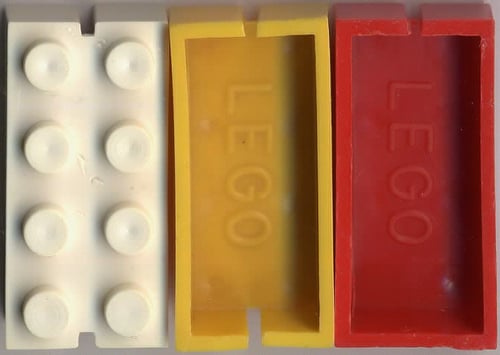
Image Credit: Historia.com
The blocks weren't too stable at this point when stacked on top of one another, though. Remember, today's Lego bricks have tubes at the bottom of them that the round studs can fit into more securely.
By 1950, Legos were introduced into the market, but to get sales numbers up, the company needed a marketing plan to compel people to buy the toy bricks.
1950s – 1999
It was Ole's son Godtfred, who became junior managing director at the Lego Group in 1954, who realized the potential of using Lego bricks as a "system for creative play" in the mid-1950s. He wanted to play off the idea that a child could craft these bricks into whatever they dreamed up -- as an outlet for their creativity and imagination.
Lego rolled with the idea. But first, the bricks themselves needed a little tweaking so that they locked together more securely. This led to the current brick model being created and patented in 1958. By 1967, Lego was creating 218 different elements -- not counting color variations -- and were selling between 18 and 19 million Lego sets each year.
With a patent under their belt and a new focus on interlocking bricks instead of toys in general, the Kristiansens set out to strengthen the Lego brand. One of their first major marketing plays was in opening their very first Legoland resort in Denmark, which saw 625,000 visitors in its first season.
In 1968, the company released a short film advertising Legoland's opening, shown below. The narrator says: "Who needs reality when you can wander 'round this knee-high paradise and watch miniature jousting beneath the castle walls?"
By 1980, Lego reported that 70% of all Western European families with kids under 14 years old had Lego bricks in their home. The company was on a roll.
During the next 20 years, Lego ran a variety of marketing projects such as launching the children's magazine Lego Clicks (now Lego Life Magazine), creating a series of children's books in collaboration with the Danish Egmont Group, and undergoing several logo redesigns.
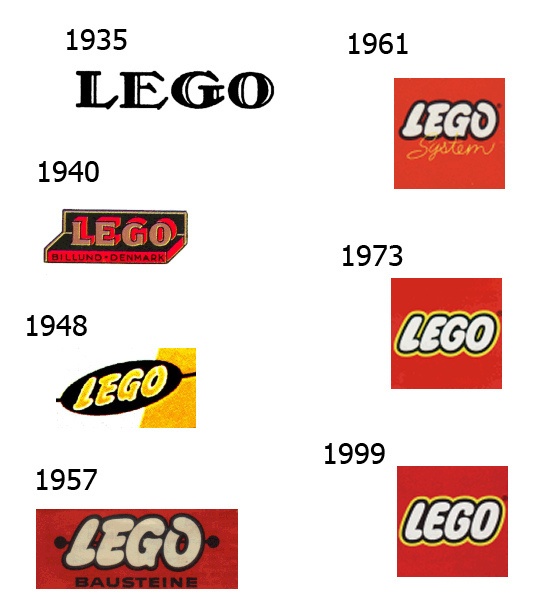
Image Credit: eingeng
And, to finish off the 20th century with a bang, the Lego brick was named one of Fortune Magazine's "Products of the Century."
But in 1999, the company found that it needed to change.
1999–2000: A Cultural Shift
For 67 years, Lego created and marketed its famous interlocking bricks in a silo -- without looking for ideas, comments, or suggestions from its quickly growing base of customers and fans. There were two main reasons for this.
Reason #1: There was a certain paranoia around creating products for children.
"When you're dealing with kids, everybody in the company is scared," said Jake McKee, who was a leader for Lego's community team from 2000 to 2006. "If a kid puts [something] in the glass and then drinks it ... they blame Lego. Then you get an angry call and a lawsuit and all sorts of stuff."
In addition, Lego's legal department wasn't happy about parents threatening to sue the company for "stealing" their kids' ideas. Basically, a lot of kids were drawing out their ideas for lego sets -- like an underwater theme, for example -- and sending them to Lego. This led to issues when parents saw what they thought were iterations of their children's ideas on the shelves. (They of course, weren't taking into account the 18–24 months it takes for an idea to turn into a product).
According to McKee, it was incidents like this that set in motion an attitude of reluctance in accepting unsolicited product ideas. Over time, this turned into the company not accepting ideas from outside the company, period.
Eventually, this turned into not talking to customers at all.
Reason #2: Before the turn of the century, there hadn't been much pressure for businesses and consumers to talk to one another.
Before the 1980s and 1990s, the company-to-customer relationship was a very transactional. Even once the internet came into play, it took a while for companies and consumers to adjust to the new methods of two-way communication, so there wasn't much pressure for companies to "listen" to their customers the way they do now.
Lego got a wakeup call in 1999 when, with less than two weeks until the Christmas shopping season, its three largest sellers -- Walmart, Target, and Toys "R" Us -- told the company that they didn’t know enough about their customers.
"The culture was so closed off; it was so walled off from the rest of the world," said McKee. "We just didn't know our customers anymore."
McKee says hearing this "kind of freaked the CEO out," prompting him to build a brand new, direct business-to-consumer business unit at the company. One of the new team's goals was to find and empower consumers who were already uniting around Lego products.
What they found was surprising: A lot of the consumers who were uniting around their products weren't children ... they were adults.
Marketing to Lego's Adult Fans
Before the 2000s, Lego marketers spent basically all of their time and effort marketing to children and parents. But in the meantime, there was a growing population of adult fans -- the marketing potential of which the company had completely ignored.
For years, these adult fans had been taking to the web to start their own discussion groups, share pictures of their Lego creations, and even create their own online marketplaces to buy and sell Lego pieces and sets. It wasn't until the company added that business-to-consumer team that the company began discovering these groups.
For example, in 1994, an adult fan created an online discussion forum, which McKee says is "still one of the most robust platforms for a community I've seen on a web, built by a ... programmer that was killing some time." All for free, all for fun, and all separate from Lego's official marketing efforts and without any interaction from them at all.
"At first, we didn't really like it," said Tormod Askildsen, Lego's head of community development, in an interview. "We were a bit concerned about the various information that started to appear on different internet pages. This was mainly because we weren't used to it and didn't know how to deal with it."
"Our mindset was that we were too busy 'doing business,'" added McKee. Instead, it turns out the company was missing out on a huge marketing opportunity. Adult fans were doing things like building 25-square-foot Lego trains in the middle of malls, which saw tens of thousands of people passing by. This was really cool, really compelling free advertising for Lego.
Lego's market research also revealed that the average adult fan was spending significantly more money on Lego products per year than the average child.
"I know someone who spent $50,000 in one year," McKee said.
Later, the company would use these numbers to justify selling more expensive sets, such as the $500 Star Wars Millenium Falcon set that includes 5,000-pieces, which McKee says they can barely keep on the shelves.
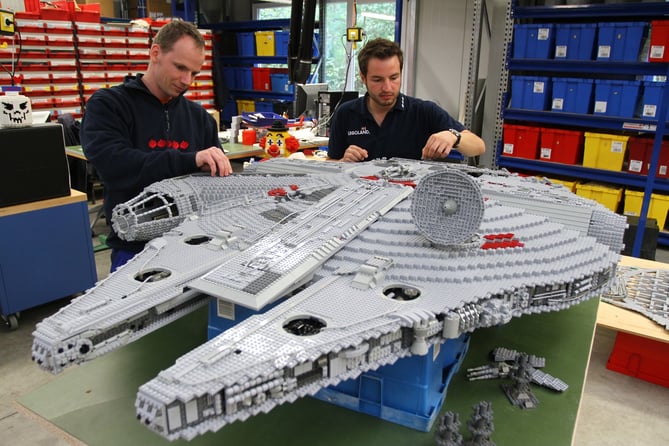
Image Credit: Gawker
The marketing potential of their adult fan base was right there in front of them. At this point, the folks at Lego set in motion a cultural shift: It was time to build personal relationships with loyal Lego fans of all ages.
To turn the culture around, Lego had to adopt what McKee calls a "higher calling model" for the business-customer relationship. In this model, there are still transactions between a company and their customers -- but at the end of the day, it's more about finding a platform bigger than both of them that both of them can rally around.
Even more importantly, says McKee, this "higher calling" had to be something that fans of any age could rally around -- whether that was parents who want their children to learn, educators who want good tools for the classroom, or adult fans who want to be taken seriously.
"Lego is actually suggesting that the brand is not competing in the toy business, but in the much more impactful -- both culturally and societally -- business of imagination," wrote Auro Trini Castelli, head of strategy at Gyro, in Advertising Age.
2005: Lego Ambassador Network
One of the first of Lego's initiatives for connecting directly with its adult fans was through their Ambassador program launched in 2005, now called Lego Ambassador Network or LAN for short. The program is made up of Lego fans aged 19–65 from all around the world, with whom Lego has built personal relationships and to whom the company turns to for ideas and advice.
“People from my team communicate with this group more or less on a daily basis, discussing different themes, ideas or to brainstorm," said Askildsen. "The ambassadors report on our discussions on blogs, create picture galleries and have further discussions with their local Lego group members."
Lego's brand communities continue to be an important compliment to its market research and product development programs.
2005: The Lego Factory
In the same year, the company launched the Lego Factory, a website where people can design their own models and then purchase all the individual Lego bricks and elements they need to build it. These pieces get shipped to them in a custom box, and they can share their creations in a gallery online.

Image Credit: Lego Factory
This is "a fantastic idea and a whole new business model for Lego, based on 1:1 customisation and on-demand supply chain," wrote SwitchMode Consulting in their case study.
Assets on the Lego website, such as the Lego Factory, helped encourage users to spend more time on the brand's website. In 2006, visitors to Lego.com spent an average of 28 minutes on the site.
2006: Shadow Print Ads
In 2006, the company hired the agency Blattner Brunner to create a series of print ads showing how Legos could be a catalyst for the imagination. This campaign was in keeping with the foundational "system for creative play" theme that sparked the Lego brick's final design in the 1950s.


Image Credit: BuzzFeed
2008: CUUSOO's Idea Crowdsourcing
What better way to engage with fans and followers than by crowdsourcing product ideas from them? In 2008, a Japanese partner of The Lego Group called CUUSOO created an online community for fans to submit their Lego set ideas. Others could then upvote ideas, and those that received more than 10,000 votes would be forwarded to product development leaders at Lego.
Among the successful projects from this initiative is the Back to the Future time machine:
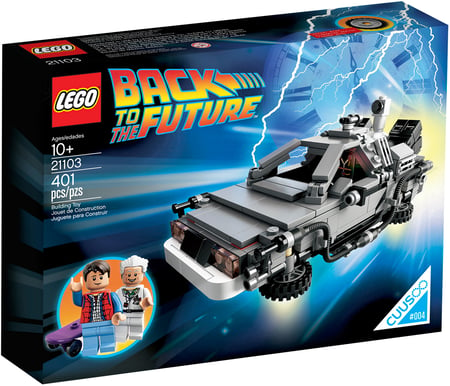
Image Credit: Lego Wikia
2011: Website Redesign
Lego hired e2x to overhaul their website design in 2011, adding Lego Club, galleries, games, and message boards to the mix. They also built separate microsites dedicated to specific product story lines, such as the Lord of the Rings, Disney Princesses, Super Heroes, and Star Wars. Each of these microsites has plot and character explanations, online games, movies, polls, quizzes, and product links.

The website redesign brought fans to their website to do the things they used to only be able to do via outside communities: interact with one another, play games, share their creations, and so on.
2012: Friends Line for Girls
While Lego did sell doll furniture sets in 1965, the company didn't do much else in the way of marketing to a female target audience until its release of the Friends Lego sets in 2012.
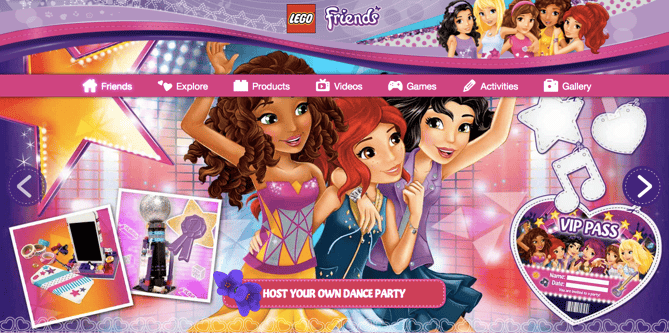
What's especially cool about the Friends Lego sets was that they aren't just pink and purple versions of the traditional, more male-oriented building sets. Instead, they were designed with the more typical female learning style in mind.
"While males tend to build things in a 'linear' fashion -- rushing to replicate exactly what’s on the box -- females prefer a more personal, less rigid approach," writes Robert Klara for Adweek. "Girls create their own environments, develop personal stories around them and even imagine themselves living inside the things they build."
Lego relayed this message in their marketing as well. In 2013, they released an ad for the product that was almost identical to a 1978 Lego ad that featured a boy.The tagline in the article says, "It's as one of a kind as she is."
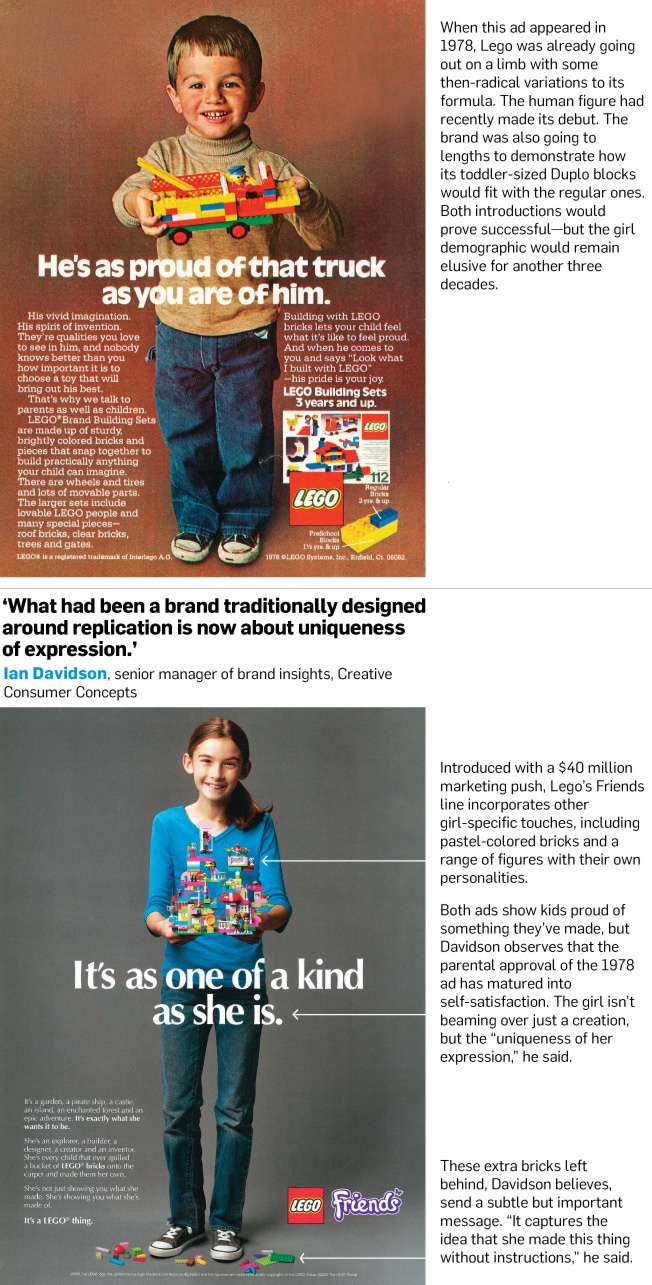
Image Credit: Adweek
Klara notes the similarities between the two ads, writing that the girl in the 2013 ad "symbolizes the one attribute that's as important to Lego as consistency: Adaptability."
The messaging in the more recent ad was tweaked to be catered for a female audience: "less about building and more about lifestyle," said Ian Davidson, senior manager of brand insights for kids marketing consultancy Creative Consumer Concepts.
2014: The Lego Movie
Finally, there's The Lego Movie -- a huge success that became the hallmark of Lego's content marketing plan. It was a box office hit and became the first film of that year to make $400 million globally.
While it didn't win an Academy Award in the U.S., it garnered significant social media attention for the Lego brand. For example, according to NewsCred, before the movie came out, Lego's typical Instagram posts would receive between 7,000 and 10,000 "likes"; whereas after the movie came out, it consistently saw 15,000-to-22,000 "likes" per post. During ABC's airing of the Academy Awards, Lego received 47,290 mentions on Twitter, with 45% registering as positive and only 14% negative, according to Amobee's Brand Intelligence division.
Adult Lego fans were -- unsurprisingly -- getting in on the action. A man named Nathan Sawaya created Lego Oscars that were given out to several Hollywood stars at the award ceremony, including Oprah.
I loved @Oprah's face with my #LEGO Oscar! #Oscars pic.twitter.com/IdU4dnAHA7
— Nathan Sawaya (@NathanSawaya) February 23, 2015
The movie appealed to both children and adults: "The kids want to play with the toys, while the adults connect with the universal message of the film -- which is that it’s important to always have an imagination, no matter what age you are," wrote Pablo Smithson for The Guardian.
Lego continues to evolve its marketing and business. It has main offices in Denmark, England, the U.S., and China, and it has quadrupled its revenue during the past decade. By embracing fans of all ages and demographics and striking a balance between consistency and adaptability, I don't doubt Lego will see its product through to the next century (or two).
![Download Now: Free Marketing Plan Template [Get Your Copy]](https://no-cache.hubspot.com/cta/default/53/aacfe6c7-71e6-4f49-979f-76099062afa0.png)
